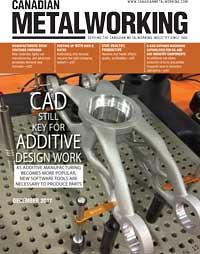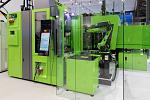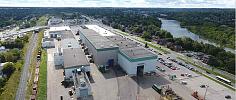- FMA
- The Fabricator
- FABTECH
- Canadian Metalworking
Machine tool health important to stay productive
Machine tool health affects quality, profitability
- January 3, 2018
- Article
- Measurement

Ballbars record movement-based errors including backlash and bad squareness/straightness. Photo courtesy of Renishaw Canada.
As the old saying goes, an apple a day keeps the doctor away. If only it were that simple.
The equivalent in the machine tool world is preventive maintenance (PM) performed on the basis of data collected from a machine tool. While some shops view PM strictly as downtime, others realize that it’s just another one of the many actions necessary to keep part quality high.
Machine data is being produced in greater quantities and in real time. This data not only tells an operator when something is wrong with the process in the now, it also can be used to predict failure before it occurs, protecting the asset (the machine) and the end product (the part).
To explain how to best control this data and keep machines operating productively for long periods, Canadian Metalworking asked Jorge Pena, product manager for Marposs Monitoring Solutions, and Philip Smith, vice president of sales and marketing for Renishaw Canada, for their opinions. Here is what they had to say.
CM: Many shop owners know that a machine needs to be tested after a crash, but when else should these tests be performed?
Pena: Rather than waiting until the machine fails, shops can employ in-process monitoring that helps detect issues and avoid collisions. With many influences on cutting processes, it’s important to leverage real-time monitoring of machine parameters as well as part or tool variations to optimize the process and limit quality risks or unplanned downtime and costs.
Smith: In the unfortunate occurrence of a machine failure, a ballbar test can be performed. This requires the results of a previously run test that it will be compared against. This can quickly establish if any damage has been done.
If machines have been tested regularly with a ballbar, the data collected over time can be used to pretty quickly see what the crash has done to the machine tool. A machine should be checked every six months at minimum if everything is running as it should be.
CM: What specific data does a ballbar collect?
Smith: The ballbar records nearly every movement-based error that occurs in a machine’s axes. Common errors include backlash and bad squareness/straightness. These testing tools can measure feedrate as well.

Machine tool sensors record vibrations, noises, temperature, torque, and abnormal forces to predict when machine maintenance is necessary. Photo courtesy of Marposs.
Reversal spikes, cyclic and scaling errors, lateral play, and servo mismatch errors also can be found and tracked over time.
The testing routine takes only 10 to 15 minutes and can be a powerful tool in helping to ensure that the machine is operating soundly at the cost of very little downtime.
CM: What other data is available from the machine that can help avoid costly crashes and out-of-spec parts?
Pena: Monitoring devices can be used to check both processes and machine conditions. Data from sensors integrated in the machine components or NC data, such as vibrations, noises, temperature, torque, and forces, can be collected and recorded to display excessive loads, critical paths, and machine status changes to predict machine maintenance.
Smith: An experienced machinist can identify nearly all machine errors by using the plot of the ballbar test.
This diagnostic report lists 22 dynamic and geometric error values and then ranks them in order of importance. Results appearing on this list don’t necessarily mean that those errors will produce parts containing errors, it just ranks data found during ballbar testing. It’s quite possible for error data to appear following testing, but no action is required because it falls within the required tolerances.
CM: What is driving the use of new technology to track this data?
Pena: The easy answer is the ongoing need for increased productivity, lower cost, and improved quality. The other part of this answer is the move toward the industrial internet of things (IIoT).
In the factory of the future, there will be a permanent exchange of information with the help of autonomous intelligent systems, which deliver a real-time image of the current production process. This information is gathered from sensors, such as those we use in our monitoring systems, that connect devices and machines to the internet, monitoring their condition and improving the performance of a production line, creating substantial cost savings.
Smith: Data collection is greatly affecting how machine tools are used. When you know a machine’s capabilities before production begins, you can reduce scrap production, and eliminate the specific machine downtime caused by searching for unknown error sources.
Taking the guesswork out of machine tool error diagnosing allows machinists to act quickly, before the machine makes out-of-tolerance parts or has a devastating crash.
CM: What is the relationship between the health of a machine’s spindle and the quality of the parts produced?
Pena: Obviously, when the spindle is not healthy, part quality is affected. Bearing failures actually are responsible for 85 per cent of spindle damage. Monitoring systems can detect the spindle torque, axis force/friction, spindle vibration, coolant flow, spindle RPM, temperature, and turret force during operation to help maintain quality.
CM: Speaking of vibration, how is it created, and how can it be reduced?
Pena: Vibration can result from various conditions, either alone or in combination. Some of the most common causes are component wear, including the aforementioned damaged roller bearings; chipped gears; an imbalance that creates a centrifugal force that causes the machine to vibrate; and misalignment of the motor and rotating shafts, which must be parallel for optimal machining. Thermal expansion can affect this alignment, and it can be noted in real time with in-process monitoring.
Marposs Monitoring Solutions, 248-370-0404, www.marposs.com
Renishaw Canada, 905-828-0104, www.renishaw.com
Related Companies
subscribe now


Keep up to date with the latest news, events, and technology for all things metal from our pair of monthly magazines written specifically for Canadian manufacturers!
Start Your Free Subscription- Industry Events
MME Saskatoon
- May 28, 2024
- Saskatoon, SK Canada
CME's Health & Safety Symposium for Manufacturers
- May 29, 2024
- Mississauga, ON Canada
DiPaolo Machine Tools Open House 2024
- June 4 - 5, 2024
- Mississauga, ON Canada
FABTECH Canada
- June 11 - 13, 2024
- Toronto, ON Canada
Zoller Open House & Technology Days 2024
- June 12 - 13, 2024
- Ann Arbor, MI




















